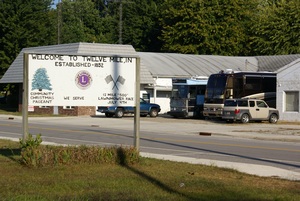Service Motors in Twelve Mile, Indiana has become something of a home away from home for our motorcoach, having spent quite a bit of time there since we bought it. As I have mentioned previously, Butch is very handy and has lots of tools, including a machine shop where he can custom fabricate things if needed. He has been very generous with his time, talent, and facilities, giving me a good place to work on our bus and helping me with it when I need it (which is most of the time). We often stop there enroute to other places, especially rallies that Butch and Fonda are also attending. Once again, we spent the day camped there.
Service Motors is Butch and Fonda Williams’ Crosley automobile parts business. They are the only full-line parts supplier for these wonderful little cars, last made in the early 1950’s, and have an active customer base. They rarely close their business, but decided they would for the week while we attended the FMCA GLAMARAMA13 rally in Goshen, Indiana. (Butch and Fonda are basically the same ages as us and were married one day before we were. They have run Service Motors for 20 years and would like to retire and move in to their 1989 MCI MC-9 NJT bus conversion, which they have done themselves from scratch. The business and facility are for sale.)
Linda worked with Fonda on some accounting issues while Butch attended to various bus and business tasks. I spent the day repairing a leaky fitting on the fuel return line from the Aqua-Hot to the fuel tank. This fitting had been leaking since I installed it as part of the fuel polishing pump project. It looked like a simple enough project, which meant it would take me most of the day; and so it did.
The fitting in question was on the lower end of a check valve (back flow preventer) at the back of a small compartment, which made access difficult. (I mentioned this project in a blog post in early June 2013, and have an article about the Parker Fuel Polishing Module queued up to run in some future issue of Bus Conversions Magazine.) The compartment was covered by a beauty panel with a door, so the actual access opening was even smaller. “Luxury” motorcoaches often conceal functional systems behind “beauty” panels so that the bays look impressively sleek and shiny when the doors are opened. What I see, however, is something that blocks my access to systems that I need to work on so I decided to remove the panel, permanently. This is why simply projects take all day.
The panel was held in place by four “L” brackets concealed on the inside (of course). I borrowed an angle drive from Butch which allowed me to remove the screws fairly easily. However, when I installed the electrical feed and switch for the fuel polishing pump back in June, I drilled a hole through this panel, ran a wire through it to the pump, and mounted the switch on the outside of it. I dismounted the switch and removed the ring terminal from one of the wires as it would not fit through the hole otherwise. With the switch and wires out of the way I was able to remove the panel after cutting loose some old rubber caulk along the bottom edge. This is why simple projects take all day.
The “compartment” in question is just the extra bay space at the business end of the Aqua-Hot. In addition to the fuel polishing pump it houses the coolant expansion reservoir and fuel filter / water separator for the Aqua-Hot as well as the fresh water pump for the domestic water system. Fortunately the cover on that end of the Aqua-Hot slides off easily after removing only three easily accessible screws (it happens occasionally). This made access to the leaky fitting much better.
The fitting was NPT male on one end, for threading into the bottom of the check valve, and barbed on the other end for attaching the fuel return line from the Aqua-Hot. Barbed fittings are designed for a one time, press on installation of a rubber line, i.e., once the line is pushed on it does not leak and it does not pull off. To remove it I had to cut it just below the fitting. I was then able to unscrew the fitting from the check valve. I was fairly certain that this junction was the major source of the leak. The threads still showed remnants of Teflon thread tape, but not much.
The other potential leakage point was the seal between the two halves of the check valve itself. The check valve is a two-piece body with internal parts, and there is a gasket between the two pieces of the body. I had inadvertently loosened this joint when installing the fuel polishing pump and had not been able to re-tighten it in place because of the limited access. Although I had a spare check valve, I decided to try and tighten the one that was already installed as replacing it meant cutting additional tubing and un-threading/re-threading additional joints.
Butch’s brother John came over in the morning to help Butch (and me) with anything that needed to be done. Butch had him change out the element on his main engine fuel filter / water separator while he worked on other bus and business issues. Fonda split her time between business things and loading their stuff on their bus. Even when they are closed, there is business to attend to. By the time I finished my little project it was well into the afternoon. Butch and Fonda worked a while longer and then we headed off to Rochester for dinner at Alejandra’s Mexican-American restaurant. It was 9 PM by the time we got back to the coach and we headed off to bed.
